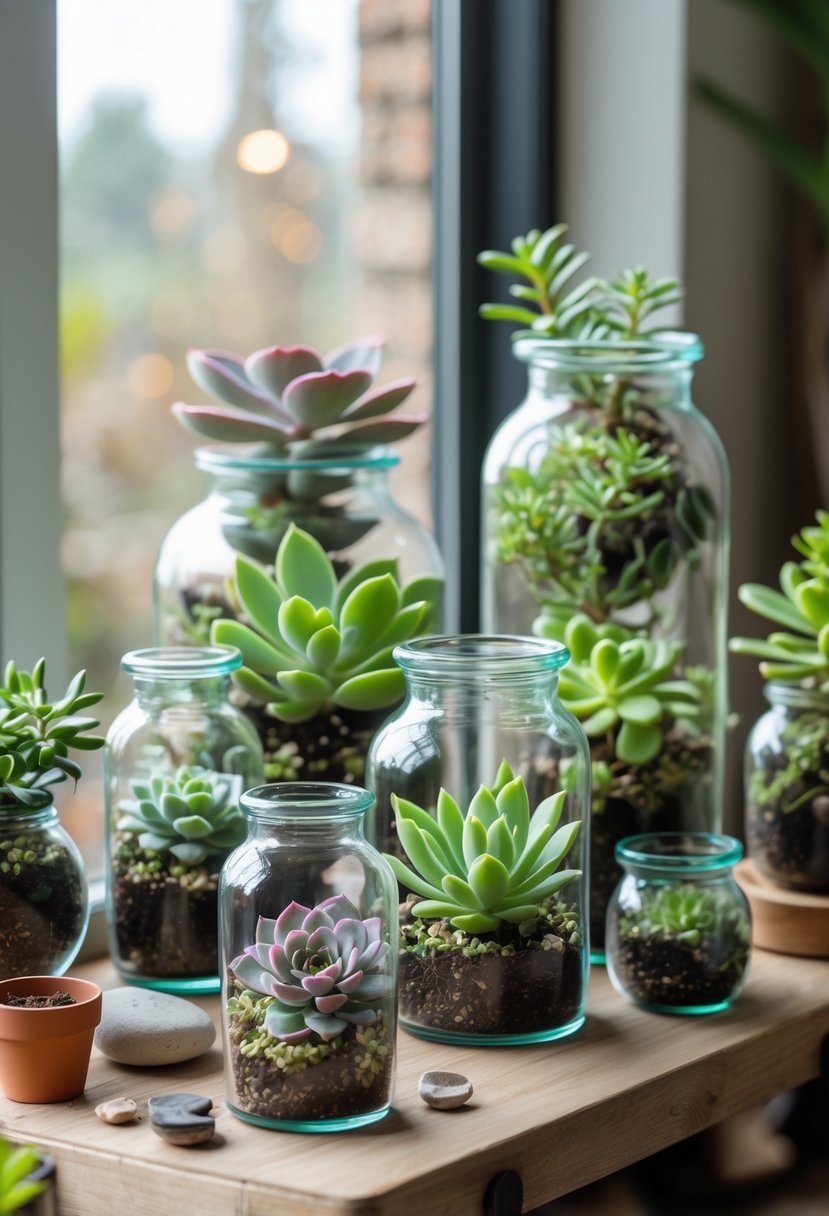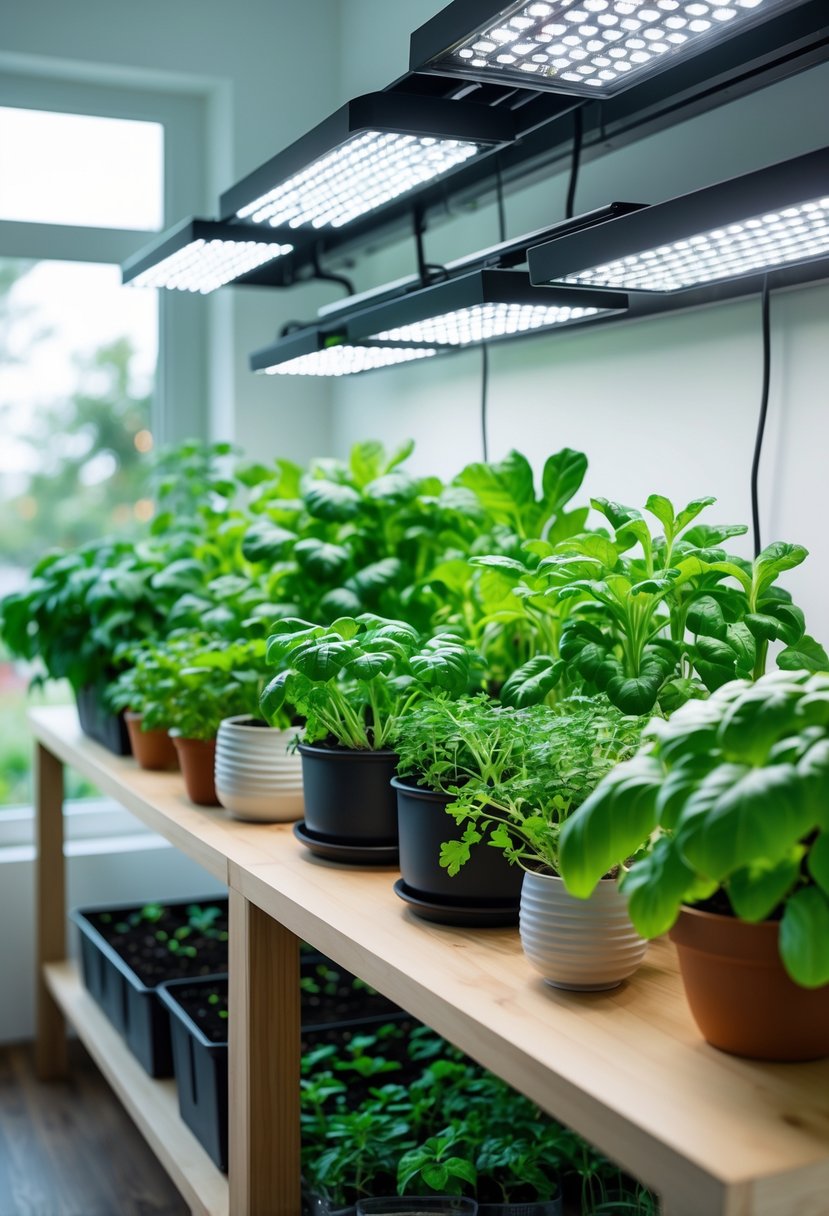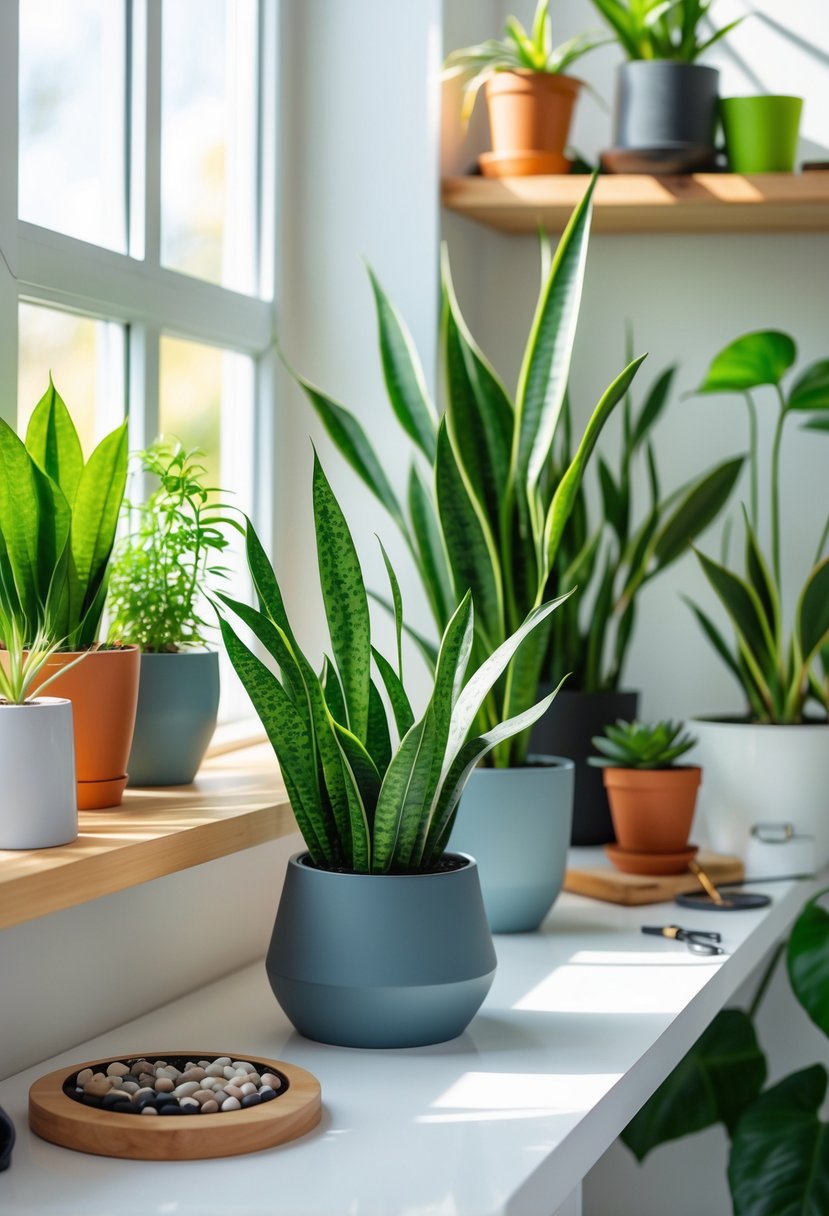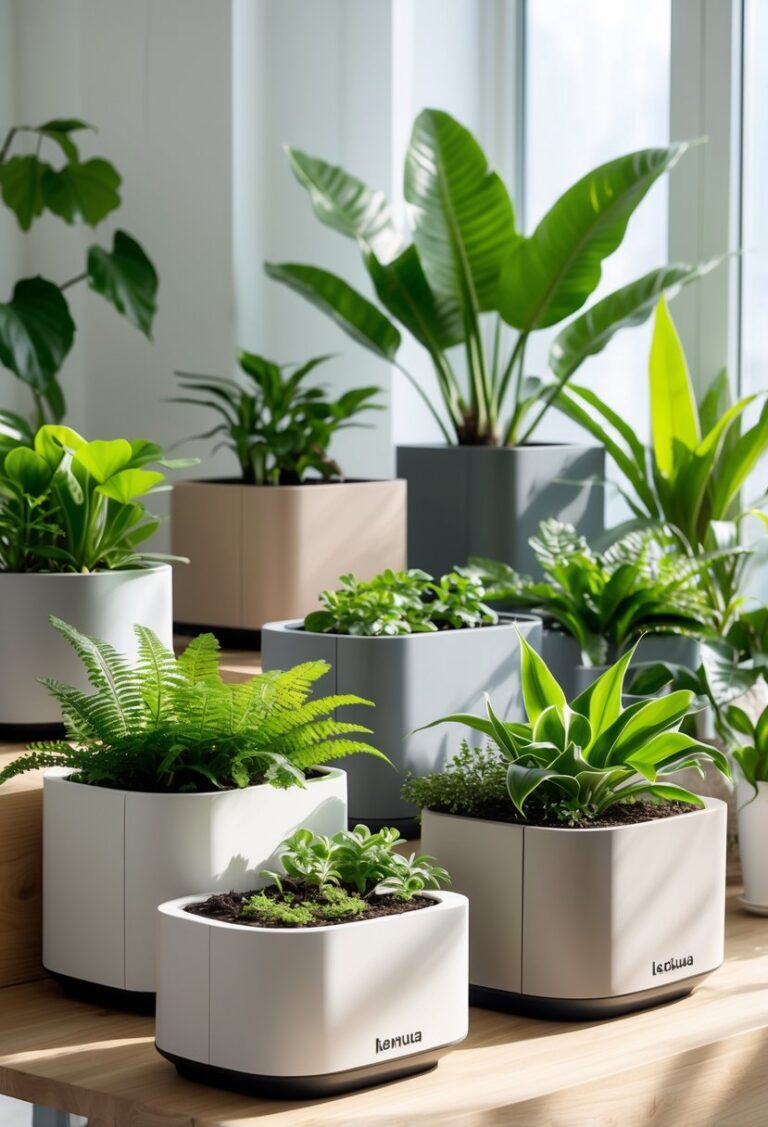15 Indoor Gardening Ideas for Enhancing Small Spaces Easily
Indoor gardening has become a popular way to bring nature inside homes. It offers a simple way to add greenery, improve air quality, and create a relaxing environment. People can choose projects that fit their space, experience level, and light conditions.

This article shows 15 indoor gardening ideas that anyone can try to brighten their living space and enjoy the benefits of growing plants indoors. These ideas work for small apartments, large homes, beginners, and experienced gardeners alike.
Indoor Gardening Ideas
1. Vertical Herb Garden with Wall-Mounted Planters

A vertical herb garden uses wall-mounted planters to save space. It allows growing herbs like basil, thyme, and mint in a small area.
These planters can be made of wood, metal, or recycled materials. They keep fresh herbs within easy reach in any room.
2. Terrarium Jars with Succulents

Terrarium jars are a simple way to add greenery indoors. They hold small succulent plants, which need little water and care. Clear glass jars let light in and show off the plants beautifully. These make neat, low-maintenance decorations for any room.
3. Aquatic Plant Water Garden with Water Lilies

An aquatic water garden with water lilies adds beauty and calm to indoor spaces. Water lilies grow well in containers with clean water and enough light. They need space to spread their leaves and regular care to stay healthy.
4. Hanging Macrame Plant Holders

Hanging macrame plant holders save floor space while adding a decorative touch. They use knotted cords to hold pots securely. These holders bring a natural, textured look to indoor spaces. Many designs range from simple knots to more detailed patterns, fitting various skill levels.
5. Indoor Vegetable Garden with Grow Lights

They can grow vegetables indoors using grow lights when natural light is limited. These lights provide the needed energy for plants to grow healthy.
They work well for small spaces like apartments and allow year-round gardening. Common indoor vegetables include lettuce, herbs, and peppers.
6. Succulent and Cactus Mixed Display

A mixed display of succulents and cacti adds variety and texture to indoor gardens. They thrive in similar conditions, making them easy to care for together.
Grouping different shapes and sizes creates an interesting visual effect. Using small pots or shallow containers can highlight their unique forms.
7. Green Wall with Modular Plant Panels

Modular plant panels are pre-made units that snap together to form a green wall. They have built-in pockets for plants and soil, making installation easy. These panels often include irrigation systems to keep plants watered automatically, reducing maintenance effort.
8. Kitchen Windowsill Spice Garden

They can grow herbs like basil, thyme, and parsley on a sunny kitchen windowsill. This keeps fresh spices close while cooking.
Containers should have good drainage to prevent overwatering. A small indoor garden adds convenience without taking much space.
9. DIY Mason Jar Indoor Garden

A DIY Mason jar indoor garden is simple and practical. It uses clean jars filled with soil to grow herbs or small plants. This setup fits well on windowsills or counters where sunlight is available.
Mason jars are easy to move and keep clean. They make indoor gardening accessible, even in small spaces. Regular watering and good soil are key for healthy plants.
10. Air-Purifying Snake Plants Arrangement

Snake plants are easy to care for and help clean indoor air. They fit well in different rooms like bedrooms and offices.
Arranging them in groups or with other plants can add style while improving air quality. Their tall, upright leaves work well in small spaces or on shelves.
11. Miniature Bonsai Tree Collection

A miniature bonsai tree collection adds elegance and calm to indoor spaces. These small trees require careful care but do not need much room. They fit well on shelves, windowsills, or desks, providing a natural touch to any room.
12. Self-Watering Indoor Garden System

A self-watering system uses a water reservoir to keep soil moist over time. This reduces the need for frequent watering and helps prevent overwatering or underwatering. It suits busy people and those new to indoor gardening. These systems keep plants healthy with less effort.
13. South-Facing Indoor Citrus Trees

South-facing windows provide the best light for indoor citrus trees. These trees need at least 6 to 8 hours of direct sunlight daily.
Placing citrus trees in this spot helps them grow strong and produce fruit. If sunlight is limited, grow lights can support their needs.
14. Terracotta Pot Herb Garden

Terracotta pots create a classic look for indoor herbs. They allow good airflow and help prevent overwatering.
Herbs like basil, rosemary, and thyme grow well in these pots near a sunny window. They add both style and freshness to the home.
15. Indoor Fern Corner with Moisture Tray
Ferns do well in bright, indirect light and need consistent moisture. A moisture tray helps keep humidity high, which ferns prefer.
Place a shallow tray with water and pebbles under the fern pot. This raises humidity without making the soil soggy. It supports healthy growth and keeps the fern lush.
Essential Tools And Supplies
Indoor gardening requires careful choices in containers, soil, and basic tools. These elements support plant health, help manage space, and simplify daily care. Selecting the right options ensures plants thrive inside the home environment.
Choosing The Right Containers
Containers must fit the plant’s size and growth needs. Plastic pots are lightweight and retain moisture well, making them good for beginners. Terracotta pots allow better airflow to roots but dry out faster, so watering schedules may need adjustment.
Drainage is key. Every container should have holes to let excess water escape. This prevents root rot and keeps plants healthy. Choose containers that fit your available light, as some materials may absorb heat and affect the soil temperature.
Shape and style also matter. Deeper pots are better for plants with long roots, while shallow containers suit succulents and herbs. Consider using containers with trays to catch extra water and protect surfaces.
Selecting Potting Mix For Indoor Plants
Indoor plants generally need potting mixes that offer good drainage and air flow. Avoid garden soil—it’s often too heavy and can carry pests. A typical indoor potting mix includes peat moss, perlite, and vermiculite.
Peat moss helps retain moisture without becoming soggy. Perlite improves aeration and drainage, preventing roots from sitting in water. Vermiculite holds moisture and nutrients to feed plants longer.
Some plants, like succulents and orchids, need specialized mixes. Cacti mix is grittier to mimic desert soil, while orchid mix uses bark chips for better airflow. Choosing the right mix helps plants grow strong and resist disease.
Basic Gardening Tools For Indoor Use
Indoor gardening needs a few essential tools to keep plants healthy and manageable. A small watering can with a narrow spout allows precise watering at the base, preventing leaf damage.
Pruning shears or scissors are important for trimming dead leaves and shaping plants. Choose ergonomic, sharp tools to avoid crushing stems. A spray bottle can help increase humidity for plants like ferns and peace lilies.
Additional useful tools include a moisture meter to check soil dampness and a small hand rake for loosening soil. Organizing these tools in a compact kit makes indoor gardening easier and more enjoyable.
Indoor Garden Maintenance Tips
Proper care is essential for keeping indoor plants healthy and vibrant. Knowing how to balance light and watering, and staying ahead of pests, will help your garden thrive.
Managing Light And Watering Needs
Different plants require different amounts of light and water. Most indoor plants do well in bright, indirect light. Place plants near a window that gets morning sun or use grow lights if natural light is limited.
Watering should match the needs of each plant. Overwatering is a common mistake; let the soil dry out slightly before watering again. Check moisture by sticking a finger about an inch into the soil. Plants like succulents and cacti need less frequent watering, while tropical plants prefer consistently moist soil.
Using pots with drainage holes helps prevent water buildup. Grouping plants with similar light and water needs can make care easier and more effective.
Preventing Common Indoor Plant Pests
Indoor plants can attract pests such as spider mites, aphids, and fungus gnats. These pests often thrive in dry conditions or from overwatering.
Regularly inspect plants for tiny webs, sticky residue, or damaged leaves. If pests are spotted, isolate the affected plant immediately to stop spread.
Natural remedies like insecticidal soap or neem oil work well without harsh chemicals. Wiping leaves and keeping the area clean can reduce pest risks. Avoid overwatering and improve air circulation to discourage pests from settling on plants.
Frequently Asked Questions
Indoor gardening can work well even with limited space or unique home layouts. Using grow lights, smart containers, and vertical setups helps make the most of available areas. Creative designs bring life and function to rooms without taking up too much space.
How can I create a vegetable garden in a limited indoor space?
Using grow lights is essential when natural light is not enough. Compact containers or vertical racks let gardeners grow multiple plants in one spot.
Plants like lettuce, spinach, and cherry tomatoes do well in small indoor setups. Choosing dwarf or compact vegetable varieties saves space.
What are some creative mini garden designs for inside the house?
Terrarium jars with succulents provide a simple way to bring nature indoors. Hanging macrame plant holders maximize vertical space and add a decorative touch.
Wall-mounted planters are great for herbs or small plants. Combining these can create a layered, living design on empty walls.
What are the best plants for a living room indoor garden?
Air-purifying plants like snake plants and pothos thrive indoors and improve air quality. Medium-sized plants such as rubber plants add structure without crowding the room.
Succulents and cacti suit sunny spots and need little care. Mixing plants with varied leaves and textures creates visual interest.
How can I set up an indoor herb garden in a small apartment?
Vertical herb gardens using wall-mounted planters save counter space. Choosing herbs like basil, mint, and parsley works well indoors.
Grow lights help when windows are not sunny. Using containers with good drainage keeps herbs healthy.
What are innovative ideas for an indoor garden under stairs?
The area under stairs often has limited light and space. Low-light plants such as ferns and ivy grow well there.
Custom shelving or tiered plant stands fit the sloped space. Adding small grow lights can boost growth in darker spots.
How can I incorporate indoor gardening in my home decor?
Using hanging macrame holders blends plants with decorative style. Colorful pots and varied plant sizes create stylish arrangements.
Terrariums and aquatic water gardens add unique elements. Grouping plants with furniture and art brings harmony between nature and design.

